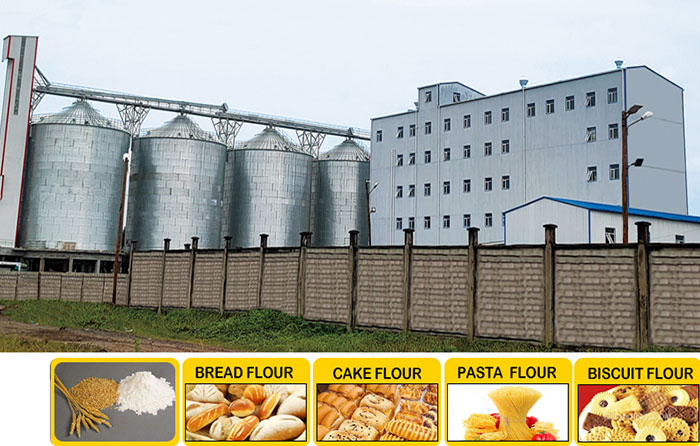Wheat grinding, or milling wheat, involves processing the grain through a series of machines to separate the bran and germ from the endosperm, which is then ground into flour. This entire procedure, known as the flour milling process, is crucial for producing high-quality wheat flour milling results that are used in a wide range of food products.
Wheat milling is a complex process that transforms raw wheat into high-quality flour, involving several distinct wheat processing steps. The wheat milling process begins with the cleaning and conditioning of the wheat to remove impurities and adjust moisture levels. Next, the wheat is tempered, which involves adding water to toughen the bran and soften the kernel, making it easier to mill. The actual flour milling process starts with the breaking of the wheat kernels using roller mills, which separate the bran and germ from the endosperm. The resulting material is then passed through sifting and purifying equipment to further refine and separate the different components. In modern wheat flour milling facilities, this process is highly automated and controlled, ensuring consistent quality and efficiency. After the milling stages, the flour is conditioned, bleached (if required), and finally packaged for distribution. Understanding these wheat processing steps is essential for anyone involved in the flour production business, as it ensures the production of high-quality, nutritious flour.
Wheat is one of the most consumed grains in the world. It comes from a type of wheat that is grown in countless varieties around the world. In the beginning wheat grinding required manual grinding, but with the development of technology it is now possible to grind large quantities by wheat flour milling machines, which has greatly increased productivity.
Let PINGLE help you start a wheat milling business!

Wheat ranks among the world’s most essential grains, cultivated in a myriad of varieties globally. The evolution from manual to mechanical milling has revolutionized the industry, enabling the mass production of flour through sophisticated wheat flour milling machines. This leap in technology has significantly boosted productivity. The milling process, crucial for converting wheat into flour, entails the meticulous separation of bran and germ from the endosperm and its subsequent reduction to fine flour, encompassing several key steps.
Flour milling is the process of grinding the grain into flour. Milling of wheat involves separating the bran and germ from the endosperm and reducing the endosperm to fine flour. It can be divided into the following steps.
Step 1: Cleaning
Sticks, stones and other such impurities are removed from the wheat. Then, the whole pure wheat is sent to the conditioning tank for further processing.
Step 2: Tempering and Conditioning
At this stage, the wheat is soaked in water in order to easily remove the bran. Conditioning is done prior to milling to ensure uniform moisture content throughout the grain. The moisture helps prevent the bran from breaking down during the milling process.
Step 3: Grinding
This is a particularly important stage where conditioned and cleaned wheat is mixed to produce the desired type and quality of flour.
Step 4: Separation
The grains then pass through a series of rolls that rotate at different speeds. The bread rolls separate only the small wheat grains in order to separate the inner white part from the bran.
Step 5: Milling
The wheat is milled into pieces by a machine. It is then passed through a sieve, from which the coarse meal is further processed by repeated grinding and sieving. The meal is then transformed into fine flour, wheat germ and bran.
Step 6: Blending
Here, the ingredients are mixed to produce different flours. For example, a mixture of wheat bran and white flour produces whole wheat flour.
The entire wheat processing steps and wheat flour milling process involve multiple links and technologies, each of which needs to be precisely controlled to ensure the quality of the final product. Together, these steps constitute the core content of modern wheat flour milling technology.
Explore the precision-engineered steps of wheat milling with PINGLE’s machinery, designed for optimal performance. Each phase, from cleaning to final milling, is a critical component in the transformation of wheat into high-quality flour. Our advanced equipment ensures thorough cleaning, perfect grain conditioning, and precise grinding, resulting in superior flour consistency. With PINGLE’s technology, every step in the milling process is streamlined for efficiency, ensuring your flour meets the highest standards of the industry.
The early flours produce white flour that becomes less white in the later stages and the number of bran particles increases. The mixture of white flour and other streams produces brown flour When all other streams are mixed in their original quantities, you get whole wheat flour.
It should be noted that the type of flour to be produced is influenced by the different qualities of the wheat entering the mill. Further variations in characteristics, such as flour color, must be ensured by mixing the various flour streams together at the time of milling.
Capitalize on the professional wheat flour milling process with PINGLE’s flour machinery. Our advanced technology is designed to streamline your production and ensure the highest quality flour. Don’t wait to take your wheat flour milling operations to the next level. Contact PINGLE today to find out more about our machines and start your journey towards wheat flour milling excellence.
Are you interested in learning more about wheat flour milling machines for sale and how they can benefit you? Contact us today to secure an expert consultation!
Copyright © Hebei Pingle Grain Technology Intelligent Equipment Co.ltd. All Rights Reserved | Sitemap | Technical Support: 